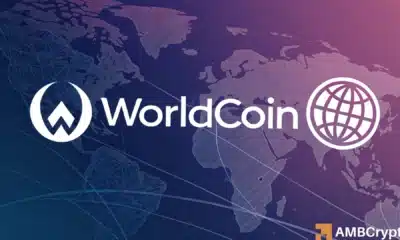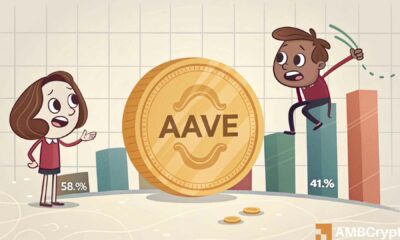
Much has been written about the unfriendly regulation, stance or even criminalization of cryptocurrencies that some countries have adopted. Indeed, Bangladesh has taken its war on crypto to the next level by passing laws which enable cryptocurrency holders to be sentenced to 12 years in prison. Other countries like Switzerland, the home of the aptly named ‘Crypto Valley’, the crypto island of Malta and Singapore have gone against the grain and welcomed blockchain projects with open arms.
With such a disparity and polarization of attitudes to cryptocurrency and crypto projects, it’s not surprising that crypto projects and developer communities are relocating themselves to these crypto havens. Maybe hardline countries like Bangladesh, Bolivia, and Egypt will wake up one day and realize that they have excluded themselves from perhaps one of the greatest opportunities of our lifetime. For now, crypto talent is becoming increasingly concentrated in these havens for innovation. In this article, we’ll take a deeper look at Costa Rica and explore why this small Central American nation is one of the fastest growing crypto paradises on the planet.
How Pro Crypto Is Costa Rica?
Cryptocurrency is all about creating and deploying alternative payment systems and enabling it to be used as a medium of exchange. The most powerful medium of exchange is probably the direct trading of a person’s’ time for value. After all, most people need a salary to live on and enabling crypto salary payments means that workers have a real choice to accept cryptocurrency over fiat. Needless to say, in the vast majority of countries in the world prohibit employees from accepting crypto as a means of salary payment.
In Costa Rica, things are a little different. It is one of the only countries in the world that employees can legally take their salary in crypto. However, there are terms and conditions attached. In Costa Rica, salary payments up to the minimum wage must be paid in fiat and anything over that can be legally paid in crypto. That means that any salary payments over €383.90 per month can be paid in crypto. Yes, it would be nice for the Costa Rican government to enable crypto payment for any level of salary payment. However, this regulatory stance just goes to show how progressive the country is when it comes to alternative payment methods.
Costa Rica’s friendly stance to crypto hasn’t gone unnoticed by blockchain businesses, with many seriously considering relocating, or having moved, to the Central American nation. It is also not surprising that Costa Rican crypto adoption levels are rising quickly and that provides blockchain businesses with a unique opportunity to get feedback on their product from real users. The nation is also home to one of the most biodiverse areas in the world and has some of the most breathtaking scenery. We imagine that the draw of increasing crypto adoption, friendly regulation, and an outstanding environment, will only strengthen and enhance the appeal of this emerging crypto paradise.

Source: upackweship.com
What Other Factors Make Costa Rica A Crypto Paradise?
Unlike tech movements like the dotcom boom of the late 1990s, cryptocurrency is a global phenomenon. This has led to many blockchain projects taking a ‘go anywhere’ approach to business operations, with many trying to secure a presence in key global regions.
Infrastructure:
Great internet connectivity lies at the heart of every crypto project. However, many countries are dependent on a single fiber optic connection to deliver the bulk of the bandwidth to a single country or region. In 2006, an earthquake in Asia managed to cause damage to both the Asia Pacific Cable Network and the SEA-ME-WE-2 link. The result was a significant disruption to internet service providers in Taiwan, Singapore, South Korea, and Hong Kong. One of the draws of Costa Rica is that it enjoys one of the best online infrastructure in the world and enjoys access to four major networks:
- MAYA-1
- ARCOS-1
- PAC
- A terrestrial fiber optic network.

Source: CINDE
This means that unless there is nuclear Armageddon in the region, then chances are that blockchain teams working in Costa Rica will still be able to maintain their networks, manage remote teams from around the world and continue to work on their projects.
Costa Rica is also home to one of the biggest renewable energy outputs on the planet. Sure, crypto mining may not be too profitable in early 2019 but 90% of all power produced by the Central American nation comes from renewable sources. This abundance of renewable energy makes Costa Rica one of the more profitable places in the world to mine cryptocurrency.

Source: CINDE
Politics:
For any crypto team wanting a base of operations in the Latin American region, Costa Rica is certainly one of the safest country choices out there. Yes, crypto pioneers like to push new frontiers in tech, however, most teams like to do this in safety. Unfortunately, the Latin American region has been characterized by military strongmen and political instability. On the other hand, Costa Rica has gained a reputation for embracing the ideals of liberty and peace. Indeed, such as Costa Rica’s commitment to peace, the nation hasn’t had a standing army for 70 years. The country is also the oldest democracy in the region too. All these factors lead to Costa Rica being one of the most politically stable nations in Latin America.

Source: eoscostarica.io
The countries political framework is also exceptionally business friendly, with flexible legal structures that make it one of the best places to build a censorship-resistant network.
Growing CryptoCurrency Adoption
For cryptocurrency supporters living in the West, you will know that it’s going to be exceptionally difficult to buy anything impulsively with your crypto whilst walking around your local high street. That’s not true at all in Costa Rica; indeed if you are hanging out in San Rafael de Escazu and feeling a bit flush, then you can pop into your local Porsche dealer and spend that 25 BTC burning a hole in your pocket. Also, wherever you are in Costa Rica, don’t be surprised to see banners on the side of stores, declaring that they accept Bitcoin and your favorite altcoin too.

Source: Reddit
Crypto merchant adoption is also not restricted to bricks an mortar businesses in Costa Rica either. AlfaTop allows anyone using a major telecoms operator in the country to top up their mobile phone using BTC, LTC, ETH, BCH, DASH or XRP.
When it comes to crypto ATMs, Costa Rica has one of the best-served countries in the world, when the size of its population is accounted for. The nation’s five million people have access to three crypto ATM’s. In contrast, the Philippines and their 105 million population have access to just one.
Costa Rica has also seen a growing trend of properties being listed for sale in crypto. Indeed, if you are interested in getting away from it all and living in a crypto paradise, then you can get a country farm in Parrita with 150 acres of land and an ocean view for just $265k in Bitcoin, Ethereum, Litecoin or Stellar.

Source: bitcoin-realstate.com
Costa Rica’s Crypto Community
In 2017, Costa Rica’s crypto community can be described as small to practically non-existent. Indeed, a crypto meetup in that year only attracted 17 participants. Flash forward to early 2019 and the nation’s crypto community has seen stratospheric growth. The best illustration of this is the TICOBlockchain Conference held on 2nd February 2019. This event is the first major crypto conference to be held in the country with over 1,000 crypto enthusiasts and industry leaders attending.

Source: Claire Ward
The key focus of the TICOBlockchain Conference is to help enable Costa Rica to become one of the leading countries in decentralized networks and blockchain tech. The conference has a little something for everybody, with two separate tracks being available:
- Business-oriented and focuses on both global trends and those in Costa Rica itself.
- Technical track geared to developers who are interested in taking the plunge into blockchain development.
Over twenty speakers and industry experts spoke at the inaugural TICOBlockchain Conference and they covered industry topics such as crypto real estate, tokenization in business to business relationships, different use cases of blockchain in different industries.
Speakers included:
- Roberto Ponce, Invermaster, Managing Director
- Chen Zur, Earnest & Young Partner, Americas Blockchain Lead
- Dmitriy Ryajov, CTO Mustekala
- Philipp von Styp-Rekowsky, CTO Nimiq
- Xavier Fernández, Co-founder EOS Costa Rica
- Jake Simmons, Software Developer Lisk Central America
The conference also managed to attract sponsors from traditional business such as Invermaster and Ernst & Young, as well as Costa Rican based crypto projects like EOS Costa Rica and Nimiq.
Which Crypto Projects Are Based In Costa Rica?
There is little doubt that the last year or so has seen rapid growth in the Costa Rican cryptocurrency community and that 2019 is likely to see it grow even more. We’ll take a quick look at some of the blockchain projects that have already decided to call Costa Rica their home.
Nimiq

Source: Nimiq
Nimiq is a payment system that is both decentralized and censorship-resistant. Yes, there are quite a few crypto payment systems out there, like Litecoin and Dash. However, the key pain point that Nimiq aims to overcome is ease of use. Cast your mind back to when you discovered crypto for the first time and think about how difficult it was to understand how to use it. No doubt, many people are interested in cryptocurrencies and we shudder to think about the number of potential new users that are put off by complex user experiences and baffling interfaces. Nimiq is attempting to solve this problem in two core ways:
- Its browser-based blockchain means that no downloads are required to connect it. This gives users the ‘it just works’ experience.
- Anyone using an Apple product will probably understand the importance of simple and intuitive user-flows. Put simply, most people like things that are easy to use and don’t require reading a complex manual. Nimiq understands this and that’s why the Nimiq payment system has been built with ease of use at its core.
The complexity of cryptocurrencies seems to be a major barrier to mainstream adoption. If we want crypto to be used by the masses then it certainly makes sense for crypto projects to be designing user-flows that have the simplicity of Apple. That’s what Nimiq are attempting to do in both their payment system and the wider Nimiq ecosystem of apps.
It seems as if the project has also got its eyes on merchant adoption. A one-click pay checkout flow has already been created and has been showcased on the Nimiq store. The team has also recently released the testnet of their Woocommerce Nimiq payment gateway to enable WordPress e-commerce businesses to begin familiarizing themselves with NIM as a payment method. When the plugin is available on the Nimiq mainnet, this will enable every WordPress powered site on the internet to accept NIM as a payment method. Now, that’s a potentially massive market with 27% of the entire internet being powered by WordPress.
The Nimiq ecosystem also contains a wide range of different concepts and apps. You can find anything from social platform tip bots which enable you to tip your favorite content creators, to a NIM-based Tamagotchi game.
EOS Costa Rica

Source: steemit.com
Created by the crypto genius Dan Larimar, the EOS platform is a blockchain-based platform for the creation of Dapps. Unlike Ethereum, EOS has been built to solve scaling problems from the get go and it’s claimed that the network can process anything between 20,00 and 50,000 transactions per second. Now, that’s a huge number when you consider that Bitcoin can only process 7 transactions per second on its main chain and Ethereum only managing 15. That’s why EOS has become known as the ‘Ethereum killer’ and is perhaps one of the most heavily backed cryptos to eventually replace ETH.
The EOS network is supported and maintained by 30 block producers and EOS Costa Rica is one of them. The Costa Rican team are of course primarily focused on maintaining the EOS network. However, they also have ambitions to help elevate the status of blockchain in the wider Latin American region and are committed to the pursuit of EOS educational initiatives in the region.
The presence of a block producer from a top five cryptocurrency like EOS certainly puts Costa Rica on the crypto map.
Conclusion
There are many more exciting and innovative blockchain projects operating out of Costa Rica and many other businesses springing up to help service these businesses. However, there is little doubt that what has attracted these projects to the Central American nation is a blend of a favorable regulatory environment surrounding crypto, growing crypto adoption rates, great internet infrastructure, all within one of the most politically stable countries in the region. The fantastic scenery and incredible biodiversity don’t hurt either.

Source: educationabroad.uccs.edu
All these benefits explain Costa Rica’s rapid growth as a crypto paradise over the last year or so. We imagine that the nation will continue to gain traction in 2019 and continue to attract an ever-increasing number of crypto projects as the hub effect increases and even more people find out about the Costa Rican opportunity. With all these things going for it, it is easy to see why the Central American nation is a raising crypto paradise and could become a stronghold for cryptocurrency in the years to come.
Disclaimer: The author holds some NIM in their portfolio and is compensated in a long-term independent consulting capacity by Nimiq. This article must not be construed as investment advice. Always do your own research.






